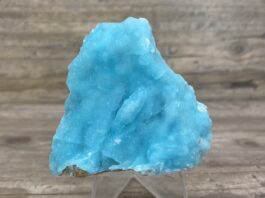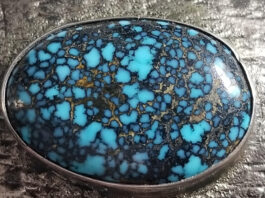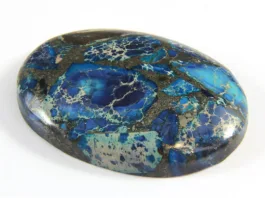Opalite is a type of synthetic glass often mistaken for a gemstone due to its alluring translucence and the play of colors similar to those seen in opals. Unlike natural gemstones, opalite is man-made, primarily from dolomite and metal to create its distinctive shimmering and milky appearance. It typically exhibits a soft, opalescent sheen with a blue or orange glow when light passes through it, making it popular in jewelry and decorative objects.


This material is also known as “sea opal glass” and “opal moonstone,” though it should not be confused with genuine moonstone or opal. The allure of opalite lies not only in its beauty but also in its affordability and the ease with which it can be crafted into various shapes and sizes. It’s particularly favored for beads, cabochons, and other forms suitable for costume jewelry and ornamental items.
Contents
Differences between natural opal and synthetic opalite
Natural opal and synthetic opalite are quite different in origin, composition, properties, and uses. Here’s a breakdown of the key differences:

1. Origin
- Natural Opal: This is a naturally occurring gemstone primarily made of silica and water. It forms over millions of years through a process of sedimentation and is mainly mined in Australia, which produces about 95% of the world’s supply.
- Synthetic Opalite: Opalite is a man-made glass. It’s artificially created from synthetic materials and is not a gemstone. It often contains a mixture of dolomite and metals to achieve its distinctive appearance.
2. Composition
- Natural Opal: Composed of silicon dioxide and water, natural opal can contain up to 20% water. Its chemical composition is similar to quartz but with a higher water content.
- Synthetic Opalite: Made from a combination of glass and various minerals, typically including elements like dolomite for opacity and metallic compounds to give it a shimmering or iridescent effect.
3. Properties
- Natural Opal: Natural opals show a unique play of color (opalescence) that can include a full spectrum of hues, depending on the conditions under which they were formed.
- Synthetic Opalite: While opalite can also exhibit a milky, luminous glow and reflect various colors, its appearance is more uniform and lacks the natural color play of genuine opal. Opalite generally glows with a blue or orange color when light shines through it.
4. Uses
- Natural Opal: Used in fine jewelry and considered a precious gemstone. It’s often set in rings, necklaces, and earrings and is valued for its unique color properties and rarity.
- Synthetic Opalite: Because it is inexpensive and easy to produce in consistent shapes and sizes, opalite is popular in costume jewelry and decorative items. It’s also used in metaphysical practices, believed by some to have healing properties.
5. Value and Cost
- Natural Opal: Highly valued, especially varieties that display a vibrant play of color. Its price can vary widely based on color, pattern, brightness, and body tone.
- Synthetic Opalite: Much more affordable and accessible due to its artificial production. It’s priced as a decorative rather than a precious material.
Understanding these differences is crucial for anyone interested in buying opal or opalite, as their aesthetic qualities and uses in jewelry and decoration vary significantly.
Properties of Opalite
Opalite, as a synthetic glass, has a set of properties that distinguish it from natural gemstones. Here’s a detailed look at its physical and optical characteristics:

Physical Properties
- Color: Opalite generally has a clear to milky white base color with a translucent to opaque appearance. When crafted, it can also display a soft, blue hue with a glowing effect, particularly when backlit.
- Texture: The surface of opalite is smooth and glass-like, which makes it feel similar to other types of decorative glass when touched.
- Hardness: Opalite is relatively soft compared to natural gemstones. On the Mohs scale of mineral hardness, it typically rates between 5.5 and 6.5. This makes it reasonably durable but still susceptible to scratches and abrasions if not handled carefully.
Optical Properties
- Luster: Opalite has a vitreous (glassy) luster, contributing to its attractive visual appeal and popular use in jewelry and ornaments.
- Iridescence: Unlike natural opal, which is known for its vivid play of color, opalite’s iridescence is more subtle and primarily based on its surface’s interaction with light. It usually exhibits a blue to orange iridescence, depending on the angle of light and the background color. This is due to the diffraction of light passing through the material, enhanced by its inherent translucency.
Opalite’s allure comes from its dreamy, otherworldly appearance, which makes it a favorite among those looking for an eye-catching yet affordable material for jewelry and decorative pieces. Its ease of manufacture and consistency also allow for a wide range of applications beyond mere adornment, such as in metaphysical practices where it is valued for its purported energetic properties.
Manufacturing and Synthetic Production

Opalite is a synthetic material that’s primarily manufactured to be used in jewelry and decorative items. Its production involves a careful process to achieve its distinctive appearance and optical qualities. Here’s a look at how opalite is typically manufactured and the materials used in its production:
Manufacturing Process
- Melting: The production of opalite begins with the melting of silica and other mineral oxides. This mixture is heated to a high temperature until it becomes molten.
- Coloring and Opacifiers: To achieve the characteristic milky and opalescent appearance, metallic oxides (such as copper or cobalt) are added. These oxides help in creating the desired colors and effects. Dolomite or other similar minerals might be included to increase opacity.
- Molding and Shaping: While the glass is still molten, it can be poured into molds or drawn out to form beads, sheets, or other shapes. This flexibility in shaping is a key advantage of synthetic glass production.
- Cooling: After shaping, the material is slowly cooled in a controlled process known as annealing. This step is crucial to prevent the formation of internal stresses and to ensure the material’s durability.
- Cutting and Polishing: Once fully cooled and solidified, the opalite can be cut into the desired forms and polished to enhance its luster and smoothness, making it ready for use in various applications.
Materials Used
- Silica: The primary component, as it forms the glass base of opalite.
- Metal Oxides: These are used for coloring and creating the opalescent effect. Typical metal oxides include those of copper for greenish-blue hues and cobalt for a deeper blue.
- Mineral Opacifiers: Dolomite is commonly used to provide opacity and the cloudy, milky appearance that is characteristic of opalite.
- Other Additives: Additional materials might be added to modify the properties of the final product, such as increasing its hardness or improving its color and brightness.
The process and materials used in the creation of opalite allow for consistency and uniformity in the finished product, which is difficult to achieve with natural stones. This makes opalite a popular choice for designers looking for reliable and aesthetically pleasing materials that can be mass-produced with relative ease.
Applications and Uses

Opalite, due to its appealing aesthetics and versatile properties, finds numerous applications across various fields. Here are some of the primary uses and applications of opalite:
Jewelry
Opalite is widely used in the jewelry industry due to its attractive luster and color properties. It can be crafted into beads, pendants, rings, earrings, and bracelets. Its captivating appearance, combined with its affordability, makes it a popular choice for fashion and costume jewelry. Opalite is especially favored for creating pieces that mimic the look of more expensive, natural gemstones while maintaining a lower cost.
Decorative Items
The translucent and glowing qualities of opalite make it suitable for decorative objects such as sculptures, figurines, and other ornamental pieces. It is often used in glass art, where it can be shaped into intricate designs that enhance its light-reflective properties. Opalite can also be found in items like candle holders, vases, and decorative glass panels, adding a touch of elegance and charm to interior spaces.
Metaphysical and Healing Practices
In the realm of metaphysical beliefs and practices, opalite is thought to have several healing properties. It is said to improve communication on all levels, especially the spiritual. It is believed to remove energy blockages, assist during transitions, and help in achieving personal goals. Opalite is also used in meditation and therapy sessions, where it is purported to induce a sense of calmness and relaxation.
Lighting and Optics
Because of its ability to diffuse light softly, opalite is sometimes used in lighting fixtures, such as lampshades or as decorative inclusions in light fixtures, where it can create a soft, ambient glow. Its properties can also be utilized in various optical applications where light manipulation is necessary, although this is less common compared to its decorative and jewelry uses.
Collectibles and Crafting
Opalite is popular among hobbyists and crafters. It is used in crafting projects, such as mosaics, mixed-media art, and DIY home decor projects. Collectors of minerals and synthetic stones also value opalite for its unique characteristics and aesthetic appeal.
The wide range of uses of opalite highlights its versatility as a material that combines beauty, functionality, and affordability. Whether in artistic, decorative, or therapeutic applications, opalite continues to be a favored choice for many.






